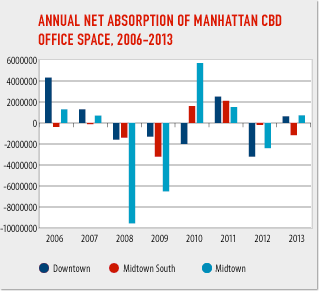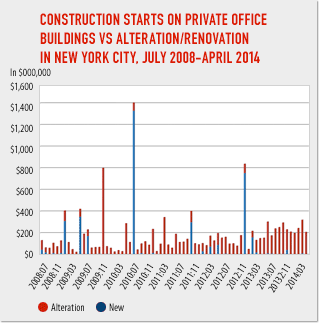
Manhattan poised to add 9 million square feet of new office space between 2013 and 2015, according to new york building congress analysis
Highest Volume of New Space in Any Three-Year Period Since 1990;
Building Congress Forecasts 10 Million Additional Square Feet Will Be Completed Between 2016 and 2018
Led by two completed towers at the World Trade Center and the first tower to rise at Hudson Yards, Manhattan is poised to add 9 million square feet (msf) of new office space to its inventory between 2013 and 2015, according to a New York Building Congress analysis.
While the new space is spread over nine development sites, more than two-thirds will be contained within One World Trade Center, 4 World Trade Center, and 10 Hudson Yards. If realized, the 9 million square feet would be the highest volume of new office space completed in New York City over any three-year period since 1990.
The Building Congress is currently projecting that another 10 msf of new space, in six buildings, will come online between 2016 and 2018. The list is highlighted by 30 Hudson Yards, 1 Manhattan West, and both 2 and 3 World Trade Center. While anchor tenants and construction financing still need to be secured, the developers of these projects have the necessary approvals as well as sites that are either currently ready or are being prepared for upward construction in the very near future.
Though not currently projected to be completed before the end of 2018, Mayor Bill de Blasio in late May voiced his administration’s support for a 1,200-foot tall office tower across the street from Grand Central Terminal. If approved and financed, that tower would result in well over one million additional square feet of new office space.
In all, the Building Congress projects 24.4 msf of new office construction from 2010-2019. This compares favorably to the 19.4 msf completed from 2000-2009, and the 10.7 msf delivered in the 1990s, though it is just half of the 49 msf that was completed in the 1980s.
“Back in 2003, government officials unveiled ambitious plans to redevelop the World Trade Center and Manhattan’s Far West Side into dynamic mixed-use districts featuring a concentration of very tall, ultra-modern office towers,” said Building Congress President Richard T. Anderson. “After a decade of upfront investments and a period of great uncertainty following the national recession, these visions are finally being realized.”
Despite the relative surge in new construction, alterations and renovations to existing office space remains the dominant source of office construction spending. Over the 70 months for which the Building Congress has data, 70 percent of construction spending in the office sector has been devoted to upgrades of existing space.
Employment, Leasing on the Rise
Two major office employment milestones were realized by New York City in July 2013. First, it marked the first time that office employment had ever reached 1.8 million. In addition, it was the first time that New York City managed to surpass its pre-recession peak of 1,788,000 jobs in July 2008.
For all of 2013, total office employment in the five boroughs averaged 1,784,100 jobs, which bested the previous high of 1,759,800, also reached in 2008. Based on the initial data and monthly employment trends, it appears likely that office employment will average more than 1.81 million jobs in 2014.
Leasing activity and asking rents have also risen. In the first quarter of 2014, 7.2 msf were leased throughout Manhattan’s central business districts (CBD), compared to 5.1 msf during the first three months of 2013 and 4.7 msf in the first quarter of 2012.
Based on data from the first five months of the year, the Building Congress estimates that 30 msf of office space will be leased in Manhattan’s main CBDs in 2014, up from 24.9 msf in 2013, and 22.3 msf in 2012.
The average asking rent for Midtown Manhattan office space was $74.27 per square foot during the first quarter of 2014, compared to $69.58 for the same period last year. Asking rents in Downtown Manhattan have risen during this period from $46.87 to $48.70, while rents in Midtown South rose from $60.10 to $63.05.
Office Outlook
While the exact timing and mix of new office construction on the Far West Side and at the World Trade Center will depend on how quickly and thoroughly the towers are pre-leased, too much has been invested in these neighborhoods to believe that they won’t begin to rise in the coming years, if not months in the case of 3 WTC.
The big question is what happens next? Will New York City then see the next wave of proposed office projects take flight? Or will there be a cooling off period while the market works to absorb all of the new space currently on the drawing board?
It is worth noting that, despite recent strong job growth and an uptick in leasing, the net absorption rate, which is the difference between move-ins and move-outs, has been negative in recent years.
The divergence in leasing activity and net absorption is explained in part by changes in office demand. More and more, large Manhattan firms are concentrating their office workers in tighter spatial configurations. Whereas 250 rentable square feet/worker had been the norm, that allowance may have dropped below 200 square feet/worker in newly-built and renovated office space.
“Clearly, prestige office firms will opt to move to the World Trade Center, Hudson Yards, and Manhattan West, which are being designed to accommodate the changing demands of the modern workplace,” added Mr. Anderson. “The question is what happens to the existing spaces these companies will vacate. New York City will need to continue generating at least 20,000 new office jobs annually into the next decade in order to keep vacancy rates from rising as well as create the demand necessary to promote further new office construction.”
He concluded, “The overall outlook for the office construction sector is decidedly positive as firms will either be looking to occupy new buildings or modernize existing spaces to remain competitive in the global economy.”Charts and Diagrams

Source: NYS Department of Labor and Urbanomics

Source: CBRE Research

Source: McGraw-Hill Dodge*
* Dodge data used for this analysis can be purchased at dodge.construction.com.



